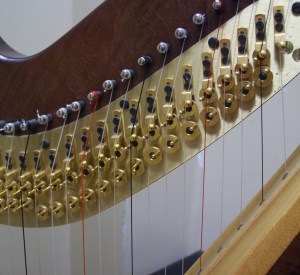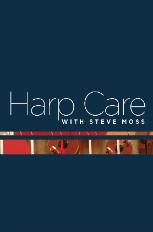Most new pedal harps come from the factory strung in nylon in the first (top) octave, and gut in the second through fifth octaves. Lever harps that use pedal harp stringing and tension, such as the Lyon & Healy Prelude, Troubadour, and Ogden, and the Salvi Ana, are normally delivered with nylon strings in the first and second octaves and gut strings in the third through fifth octaves.
When it comes time to replace a string (or a whole set), harpists realize they have choices. Strings are available in both nylon and gut from the top the way down to fifth octave A. And, wow, gut strings cost five times as much as nylon strings. Is the cost of a gut string worth it? I’m going to address this question in a series of posts, and show that the answer to this question varies by octave.
First, a little bit about the differences between gut and nylon strings. Note for note, nylon strings are more elastic than gut strings, meaning they stretch more when played. Think of the difference between a rubber band and a piece of cotton string or twine. If you stretch a rubber band, and then pluck it like a harp string, it will give, or stretch more, then snap back when you let go. If you hold a piece of string taut, and pluck it, it will stretch far less, offering your finger more resistance, until you let it go and it snaps back. While harp strings are neither as slack as rubber bands nor as stiff as cotton string, nylon strings act more like rubber bands and gut strings act more like cotton string.
This difference in elasticity translates into a different sound character in nylon and gut strings. While we usually say that a string produces a particular note, each harp string actually produces a multitude of notes when played. The most prominent note is known as the fundamental. This is the note we name the string after, and the primary frequency at which it vibrates. However, a string in motion actually vibrates at a variety of frequencies. These secondary frequencies are known as partials, harmonics, or overtones. When you play harmonics on your harp, you are isolating one of these partials, specifically the the one an octave above your harp’s fundamental.
In practice, gut strings tend to have a stronger, cleaner fundamental tone, while nylon strings have a more complex sound, with more emphasis on some of the partials and a weaker fundamental. I believe this is because a nylon string not only vibrates when played, but also stretches and contracts laterally, to a greater degree than a gut string, causing its various partials to sound more prominently.
Whew, that’s enough acoustics theory for one post. These behavioral differences in gut and nylon strings translate into differences in sound quality and character on the harp, and we’ll examine these in the next post.



0 Comments